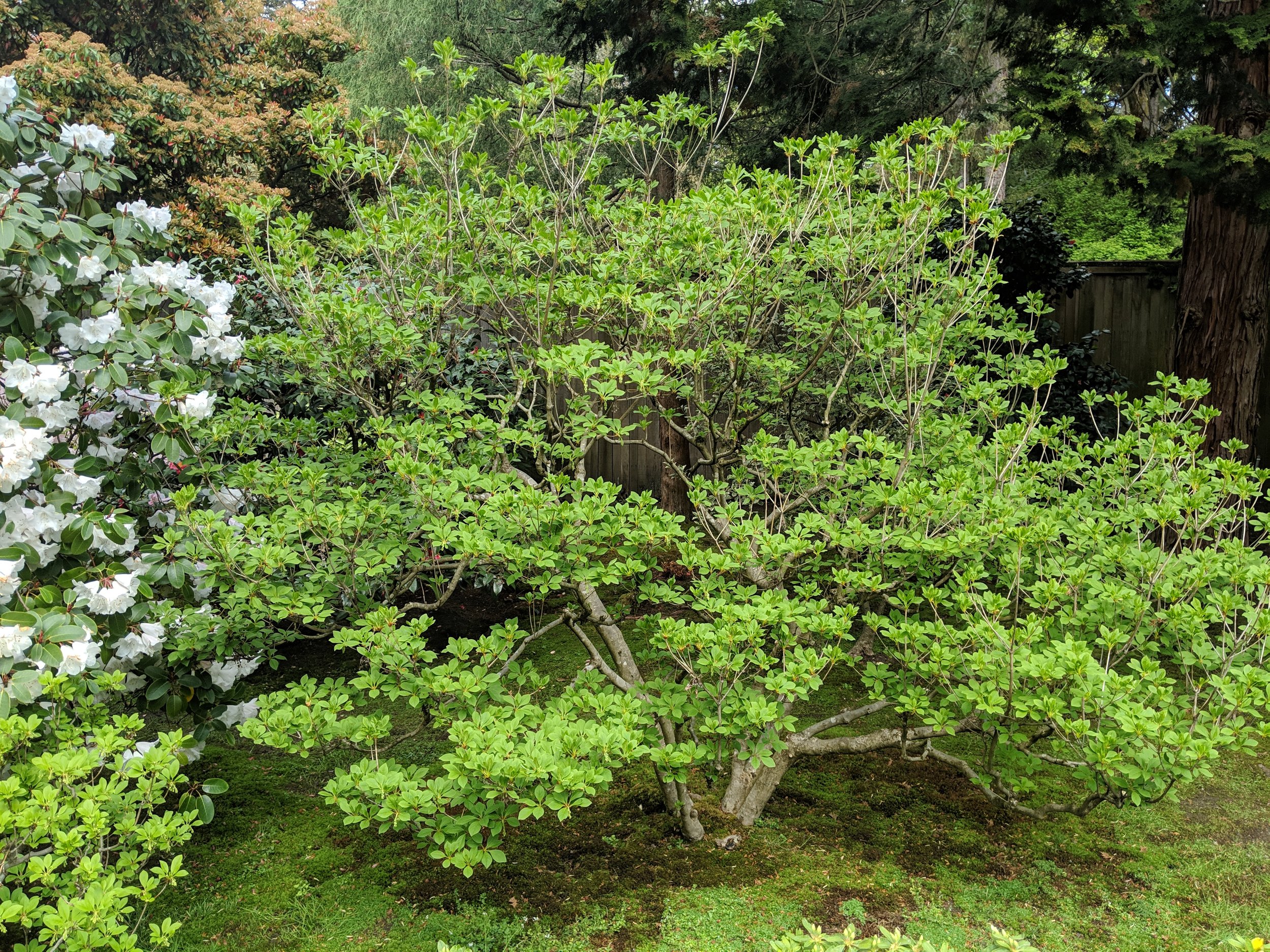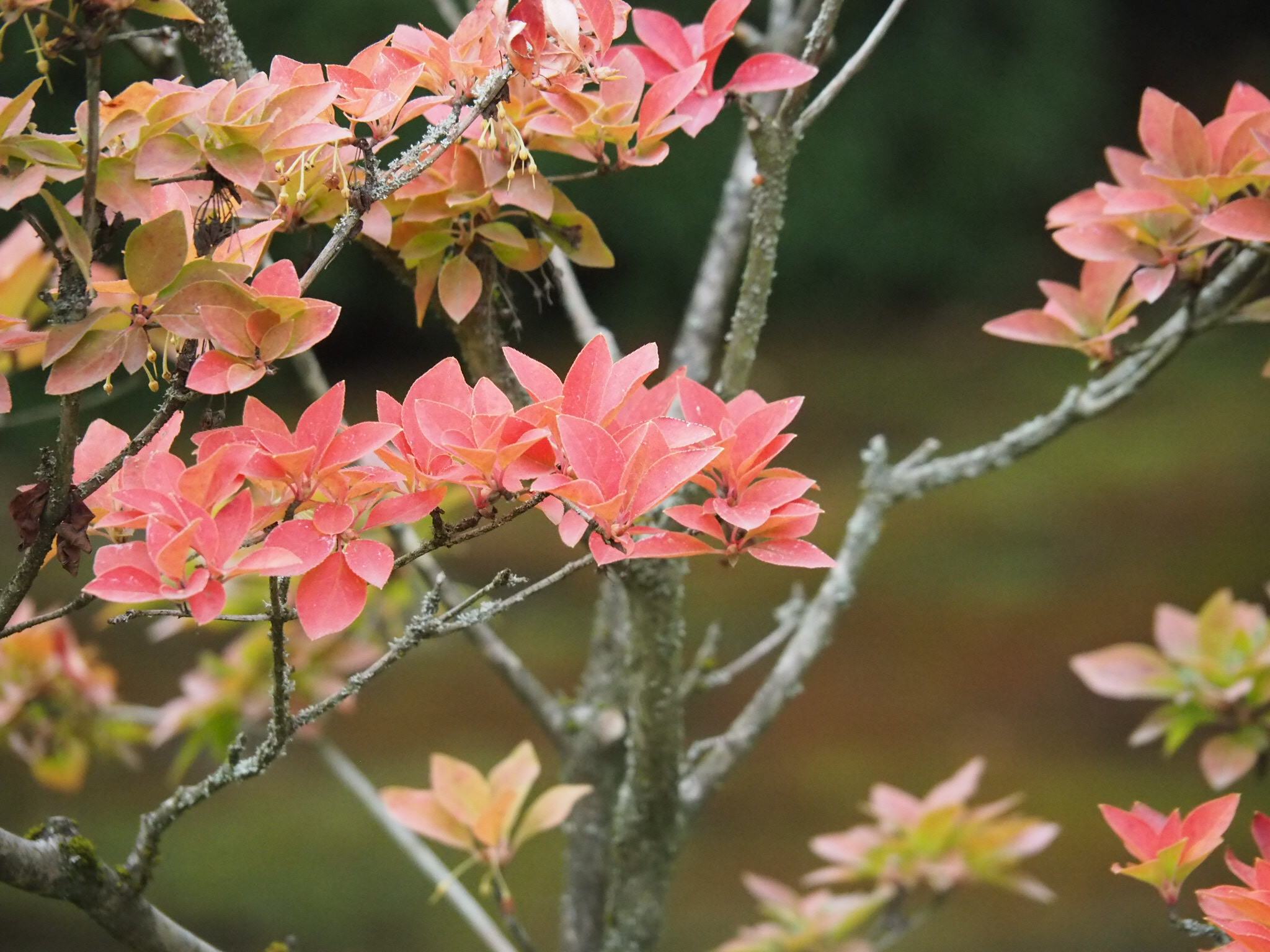Enkianthus: Delicate Late Spring Flowers & Striking Fall Color
By Corinne Kennedy
Redvein enkianthus in our garden, before the flowers open. (photo: Corinne Kennedy)
Enkianthus, sometimes known as pagoda bush, is a little-known genus in the Heather Family, Ericaceae, which also includes rhododendrons, azaleas, blueberries, huckleberries and, of course, heathers. Although its flowers are not as showy as most other spring-blooming shrubs, it’s a lovely plant with subtle charms. Uncommon in Seattle-area gardens and throughout the US, it deserves to be more widely grown. Our Seattle Japanese Garden contains two Enkianthus species that are native to Japan – Enkianthus campanulatus and Enkianthus perulatus.
The genus name, Enkianthus, derives from the Greek enkyos, swollen or pregnant, and anthos, flower – and describes the unusual blooms of a single species, E. quinqueflorus. Its flowers appear to have another flower nestled within them. There are about a dozen species in the genus, which is native to East Asia, from the Himalayas to southeast Asia, China, Korea and Japan. Three species are Japanese natives, but China, with seven native species, has more than any other country.
Most of the plants in our garden are Enkianthus campanulatus, commonly known as redvein enkianthus (furin tsutsuji in Japanese) – and the most commonly planted species in Western countries. Native to open woodlands in Japan, it’s valued for its profuse flowering and showy fall color. Cultivated for centuries, it was often planted in groups, as a hedge, or in pots. Historically, the alcove posts in teahouses were made from its rustic-appearing wood.
Enkianthus campanulatus at Mount Kohide, Japan (Alpsdake, 7/1/10, in WikiMedia Commons)
Redvein enkianthus is a narrow deciduous shrub with an upright, layered habit of growth and smooth brown bark. It is quite cold hardy (to USDA Zone 4 – minimum temperature -20 to -30 degrees F), and when planted in our area matures to about 8 feet tall by 6 feet wide. The species name, campanulatus, is from the Latin word for bell-shaped, a reference to the shape of its flowers.
E. campanulatus has glossy, medium to dark green leaves that are finely toothed and 1 to 3 inches long. Clustered at the tips of the branches, they are widest mid-leaf and narrower at each end. There is considerable variation among individual specimens, but most plants growing in full sun have attractive fall color in shades of scarlet, orange, yellow and purple.
The delicate flowers of redvein enkianthus (photo: Mary Ann Cahill)
In late spring, after the leaves emerge, large terminal flower buds open to nodding clusters of small, bell-shaped flowers. They form on the previous year’s branches – a characteristic of trees and shrubs that bloom in spring. Best viewed from close up, they are dainty and charming, resembling the flowers of heathers and lily-of-the-valley shrub (Pieris). Creamy-yellow to light orange, they have attractive pinkish-red veins and edges – and nectar that attracts bees and hummingbirds. Their fruits, unlike those of blueberries & huckleberries, are brownish egg-shaped capsules that split open when mature.
Enkianthus campanulatus grows well in dappled shade to full sun – but not hot afternoon sun. Fall color is best in full sun, but the less intense coloration of shaded plants is also attractive. Like its heather-family relatives, redvein enkianthus requires rich, moist, well-drained acid soil and regular watering during our dry summers. It is somewhat tolerant of clay soils and urban pollution, but performs poorly in alkaline soils, which causes the leaves to turn yellow (chlorosis).
Fall color of Enkianthus (Photo: Chie Iida)
The other pagoda bush in our garden is Enkianthus perulatus, white enkianthus (dodan tsutsuji). Native to rocky slopes in Japan, it is less cold-hardy than E. campanulatus – to about USDA Zone 6 (minimum temperature -10 to 0 degrees F), rather than Zone 4. Thriving in the conditions where redvein enkianthus grows best, it resembles the latter in most respects. However, its snowy-white flowers are larger, narrower at their tips, and without conspicuous veining. With a wide, dome-shaped habit, it generally remains lower-growing than other enkianthus species – less than 6 feet tall at maturity. The bright green foliage turns a beautiful scarlet or orange-red in fall. Like redvein enkianthus, it has red young twigs that age to a less-showy brown or reddish-brown color.
White enkianthus is perhaps the most popular enkianthus species in Japan. A huge, very wide-spreading specimen – about 200 years old – grows in Kairaku-en Garden in Mito City. In Western countries, however, it’s less common in cultivation and more difficult to find than E. campanulatus. The species name, perulatus, means “having conspicuous bud scales” – a description not particularly helpful to most observers.
With delicate spring flowers and attractive fall color, enkianthus species are excellent shrubs for Japanese-style gardens. Dainty, subtle and elegant, their flowers and habit contribute to the quiet, refined beauty we experience in the Seattle Japanese Garden. With no serious pest or disease problems, they should be more widely grown in the Pacific Northwest and other temperate areas with acid soils. Visitors to our garden who require predictable fall color and more deeply-colored flowers will find enkianthus cultivars (cultivated varieties) for sale at retail and mail-order nurseries.
Corinne Kennedy is a Garden Guide, frequent contributor to the Seattle Japanese Garden blog, and retired garden designer.




